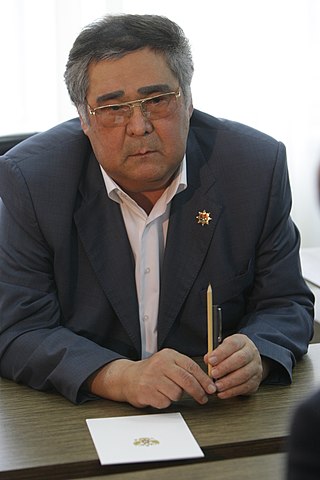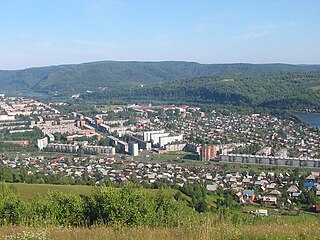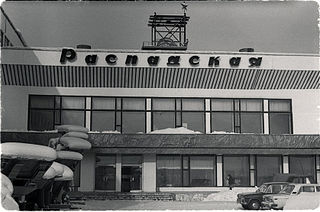
Kemerovo Oblast — Kuzbass, also known simply as Kemerovo Oblast or Kuzbass (Кузба́сс), after the Kuznetsk Basin, is a federal subject of Russia. Kemerovo is the administrative center and largest city of the oblast. Kemerovo Oblast is one of Russia's most urbanized regions, with over 70% of the population living in its nine principal cities. Its ethnic composition is predominantly Russian, but native Shors and Kalmak Siberian Tatars also live in the oblast, along with Ukrainians, Volga Tatars, and Chuvash. The population recorded during the 2021 Census was 2,600,923.
A mining accident is an accident that occurs during the process of mining minerals or metals. Thousands of miners die from mining accidents each year, especially from underground coal mining, although accidents also occur in hard rock mining. Coal mining is considered much more hazardous than hard rock mining due to flat-lying rock strata, generally incompetent rock, the presence of methane gas, and coal dust. Most of the deaths these days occur in developing countries, and rural parts of developed countries where safety measures are not practiced as fully. A mining disaster is an incident where there are five or more fatalities.

Amangeldy Gumirovich "Aman" Tuleyev was a Russian statesman. He served as governor of Kemerovo Oblast from 1997 to 2018 and was the chairman of the Council of People's Deputies of the Kemerovo Oblast briefly in 2018.

The Monongah mining disaster of Monongah, West Virginia occurred on December 6, 1907, and has been described as "the worst mining disaster in American history." 362 miners were killed. The explosion occurred in Fairmont Coal Company’s No. 6 and No. 8 mines, and was one of the contributing events leading to the creation of the United States Bureau of Mines.

The Courrières mine disaster, Europe's worst mining accident, caused the death of 1,099 miners in Northern France on 10 March 1906. This disaster was surpassed only by the Benxihu Colliery accident in China on 26 April 1942, which killed 1,549 miners. A coaldust explosion, the cause of which is not known with certainty, devastated a coal mine operated by the Compagnie des mines de houille de Courrières. Victims lived nearby in the villages of Méricourt, Sallaumines, Billy-Montigny, and Noyelles-sous-Lens. The mine was 2 km (1 mi) to the east of Lens, in the Pas-de-Calais département.

Mezhdurechensk is a city in Kemerovo Oblast, Russia. Population: 101,678 (2010 Census); 101,987 (2002 Census); 107,014 (1989 Census).

The Ulyanovskaya Mine disaster was caused by a methane explosion that occurred on March 19, 2007 in the Ulyanovskaya longwall coal mine in the Kemerovo Oblast. At least 108 people were reported to have been killed by the blast, which occurred at a depth of about 270 meters (885 feet) at 10:19 local time. The mine disaster was Russia's deadliest in more than a decade.

The Yubileinaya mine is a coal mine in the Kemerovo Oblast area of Siberia, Russia. The mine is operated by Yuzhkuzbassugol, part owned by the Evraz Group who plan to take full ownership.

The 2007 Zasyadko mine disaster was a mining accident that happened on November 18, 2007 at the Zasyadko coal mine in the eastern Ukrainian city of Donetsk.

Zasyadko Mine is a coal mining company in Ukraine's eastern city of Donetsk. Following the start of the War in Donbass in 2014 the mine became situated in rebel controlled territory.

The 2009 Handlová mine blast occurred on 10 August 2009 roughly 330 metres (1,080 ft) underground in Trencin Region, Slovakia at Hornonitrianske Bane Prievidza, a.s.s (HNB) coal mine located in the town of Handlová. 20 people were killed, nine others suffered minor injuries and were taken to hospital for treatment. Some historians have called the disaster the largest mining tragedy in Slovakia’s history. The deadly explosion, probably caused by flammable gases, occurred after mine rescuers had earlier been deployed to extinguish a fire in the Eastern shaft of the mine.
OJSC Raspadskaya is a Russia-based coal-mining company owned by Evraz (82%) and headquartered in Mezhdurechensk, Kemerovo Oblast. The company produces 7 million tons of coal per year.

The Upper Big Branch Mine disaster occurred on April 5, 2010 roughly 1,000 feet (300 m) underground in Raleigh County, West Virginia at Massey Energy's Upper Big Branch coal mine located in Montcoal. Twenty-nine out of thirty-one miners at the site were killed. The coal dust explosion occurred at 3:27 pm. The accident was the worst in the United States since 1970, when 38 miners were killed at Finley Coal Company's No. 15 and 16 mines in Hyden, Kentucky. A state funded independent investigation later found Massey Energy directly responsible for the blast.
2010 mining disaster may refer to:

The Raspadskaya Coal Mine is a coal mine located in Mezhdurechensk, Kemerovo Oblast, Russia. It is the largest coal and the largest underground mine in Russia. The mine was opened in 1973 and its construction was completed in 1977. In addition to the main underground mine, the mining complex also includes MUK-96 underground mine, Raspadskaya Koksovaya underground mine, and Razrez Raspadsky open-pit mine, as also the Raspadskaya preparation plant. The mine is the largest coal mine in Russia.
The following lists events from the year 2013 in Russia.

In February 2016, a series of explosions caused the deaths of 36 people, including 31 miners and five rescue workers, at the Severnaya coal mine 10 kilometres north of the city of Vorkuta, Komi Republic, Russia. The explosions were believed to be caused by ignition of leaking methane gas. It is the second deadliest mining disaster of the 2010s behind the Soma mine disaster, and fourth deadliest of the 21st century thus far.

Sergey Yevgenyevich Tsivilyov, is a Russian statesman, politician, economist and former military officer who is currently serving as the 3rd Governor of Kemerovo Oblast since 17 September 2018. He is the member of the Bureau of the Supreme Council of the United Russia party.

The Listvyazhnaya mine disaster was a mining accident that occurred on 25 November 2021 in a coal mine in Kemerovo Oblast, Russia. Smoke from a fire in a ventilation shaft caused the suffocation of over 40 miners. A failed attempt to rescue the trapped miners resulted in the deaths of at least five rescuers when the mine exploded. It is the deadliest mine accident in Russia since the 2010 Raspadskaya mine explosion in the same region.














